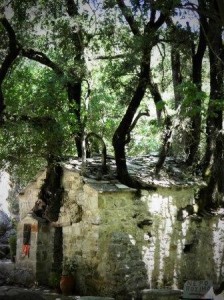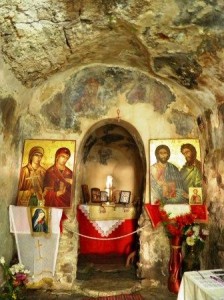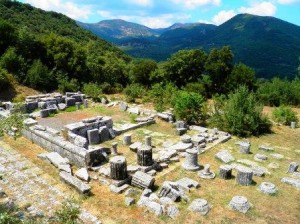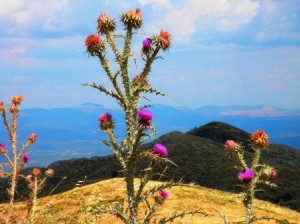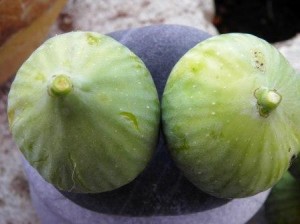TREES grow in curious places and miracles abound where you least expect them – it would seem. On the roof of the tiny stone church of Ayia Theodora, oak trees began to grow after the building was constructed in the 10th century and they’re still there today, their roots apparently reaching down through the walls of the structure towards the natural spring below. Why and how? It’s not clear. Locals say that in line with the curious history of the church, it’s a miracle. Structural experts and academics have visited and studied the church and have so far been unable to offer a scientific explanation for the odd tree growth or its longevity.
It is certainly the strangest and most oddly appealing church we’ve encountered in the Peloponnese so far. And it was especially to see this ecclesiastical phenomenon that we drove to the village of Vastas in Arcadia (a two-hour drive away) on a day when the temperature was nudging 40 degrees. The sun was blistering and yet, in the clearing of a forest where the church is situated, the atmosphere seemed cool and energising, with the natural spring that runs under the church oozing fresh, sweet water into a nearby stream.
The tiny stone church squats under the weight of the 17 trees that soar up from the tiled roof like a stiff-brushed hairdo of eccentric proportions. The curious thing is there is little trace of tree roots apart from a large knot of ancient wood breaking through the stone wall above the front door of the church and disappearing again into its structure. In the confined space inside the church, with its several icons of Ayia Theodora, there is no sign of a root system, however. From the outside, and apart from the front oak, the trees simply appear to be growing straight up out of the tiled roof itself, as if floating on air.
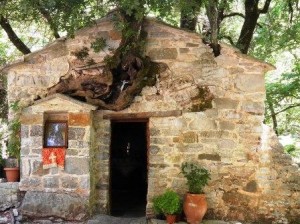
Knotty problem: The front of the church showing a section of tree root which has grown there for over 1,000 years
The local Greeks have believed throughout the centuries that this is a sacred place and that the structure is the miraculous form of Saint Theodora, who prayed before her untimely death for her body to be turned into a church, her hair to become a forest of trees above, her blood a river.
Saint Theodora’s is a curious story even for the Byzantine era in which it originated. In the 9th century, the pious Theodora wished to join a monastery, yet for reasons we’ll never understand decided against a women’s monastery and joined a male establishment instead. After disguising herself as a young man, she changed her name to the male equivalent – Theodoros – and there began her earthly trials at least.
While on one of her many travels outside the monastery to raise funds for its charitable work, a young nun from a nearby monastery, who was pregnant, claimed Theodoros was the father of the child in a bid to protect her real lover. Again for reasons that are blurred with time, Theodora kept her gender a secret and decided to take the rap for the incident as a mark of compassion for the nun’s plight, and the saint was tried and sentenced to death by decapitation.
As the story goes, when the executioner and his cohorts saw Theodora’s naked body before her burial and realised her innocence, they repented their act and built a church to honour her good deeds and her martyrdom.
It was while she was awaiting execution that she uttered her prayer with the wish to be literally turned into a church. A curious story, of course, and while the church itself may not be on a par with other sacred shrines around the globe, and while so far as we know there have been no recorded miraculous healings, the church attracts thousands of pilgrims from all over the world, who come here to keep vigil in the shaded forecourt of the church.
The church has attracted many engineering experts over the years from Greek and overseas universities. None have so far been able to explain how the walls have been able to withstand the growth of roots through them over a period of more than 1,000 years without the tiny structure of the church being destroyed.
One Greek engineer noted that the weight of the trees on the roof would be around nine tons, which is four times greater than what would normally be tolerated by a structure of this size. Added to this, during times of high winds and rain there would be an even bigger, more disastrous load on the building.
However this odd phenomenon has taken root it is worth seeing for yourself, if miracles excite you at all. Certainly this part of Arcadia is a fascinating mix of stunning mountains and plains and is only marred by the power-generation plants outside the modern town of Megalopolis. It’s an important industry in this region, but the sight of two giant smoke stacks belching out pollution, at what is sometimes said to be Athenian levels, is slightly discouraging. At least they’re not visible from every vantage point and there are plenty of stunning beauty spots here, like the archaeological site of Lykosoura.
Said to be the oldest city in the world, it has the intriguing, ruined Temple of Despoina (the Mistress) dating back to 180BC and situated on a peaceful hillside. The cult statue of the goddess Demeter was once situated here and this was the site of various ancient Mysteries we can only guess at now.
A short drive from here is Mt Lykaio, or Wolf Mountain, with staggering views of the southern Peloponnese on a clear day, and the Taygetos mountain range. It has a windswept Scottish highland feel about it, complete with bright coloured thistles growing on the hillsides and not a soul to be seen. There are tiny churches in the folds of hills, rusting signposts, and other ruined archaeological clusters with columns lying like bleached bones in long grass.
It was so swelteringly hot, however, that we had to forgo a walk up the final bit of dirt track that leads to the top of Mount Lykaio. Instead we drove back towards the plain and fell upon a natural spring water outlet by the roadside, where the water is cold, sweet and mythically refreshing. We refilled all our empty drink bottles, and later Wallace the dog jumped in to cool his heels. Or maybe he just thought that by immersing himself in the water from Wolf Mountain he’d turn into a tough-guy terrier.

Paws for refreshment: Wallace the Jack Russell cools off in the spring water that flows from Mt Lykaio
Back in the Mani, the church of Ayia Theodora with its crazy Einstein hair seems a world away and yet it is a strange co-incidence that brings it into clear focus again.
One afternoon we are swimming in a quiet cove where several Greeks are floating about under their hats when we get into conversation with a man who is paddling by. He tells us he is in the Mani for his annual August vacation, and that he comes from no other place but the village of Vastas, not far from the church of Ayia Theodora. We ask him: Is the tree growth miraculous?
He smiles under his white baseball cap and tells us that lots of smart university types have looked at the church and measured it and pondered over it. “No-one can ever explain it,” he says with a big Mediterranean shrug.
“So it’s a miracle then?”
He points to the sky. “Only the man up there knows for sure.” He winks and paddles off.
AUGUST has been sweltering. There’s hardly been a day when the temperature has been below 35 degrees, with not one drop of rain or a cloud in the sky. But August has brought the first figs and we have already raided nearby trees for our first supplies and stuffed ourselves silly with them, knowing that in a few short weeks they will all be gone. A lot like the Greek holidaymakers of August who swarm the Mani beaches and entertain us for hours with their manic beach capers and their sheer exuberance for summer, and for that first leap into a cool sea every morning.
Greeks are so completely at home by the sea, and uninhibited, that watching them at play there is a window into their eccentric souls. One morning in a cool sea as flat as a mirror I could hear a man, away out in the deep, singing at the top of his voice, for a good long while. He had a strong, melodic voice and was singing a variety of popular Greek songs, mixed with some opera. For want of something better to do, I swam out to him, and in the manner of most Greeks got straight to the point, asking him why he was singing in the sea.
“I sing in a choir in Athens,” he said, “and this is the best opportunity I get on holiday to practise at the top of my voice, on my own.” Time to leave then, but not before I had put in a request for a favourite Greek song and as I swam back to shore I could hear the first sweet bars of it drifting over the glassy sea. Where else but in Greece, eh? www.bigfatgreekodyssey.com
Marjory has written three memoirs about her adventures in southern Greece in which she also features a story about Ayia Theodora. Her latest book is A Scorpion In The Lemon Tree, available on all Amazon sites:
Her two earlier books are also on Amazon. The first, Things Can Only Get Feta is currently on a promo on the British site for 99p. Amazon links below:
